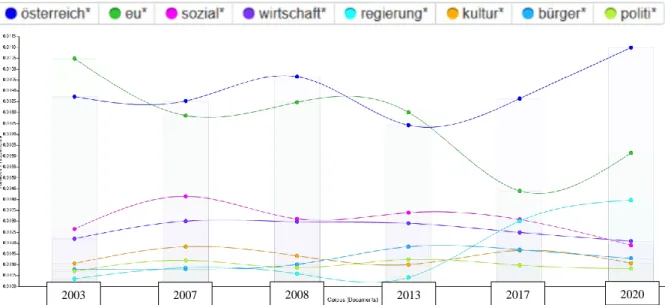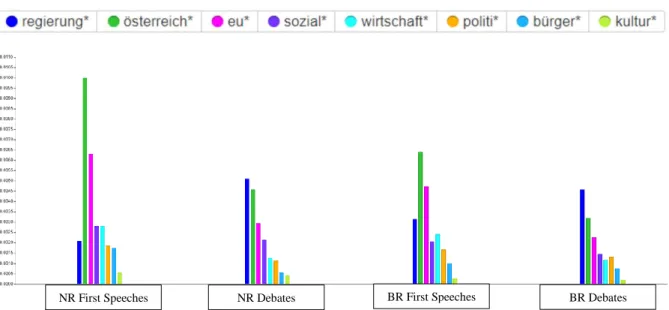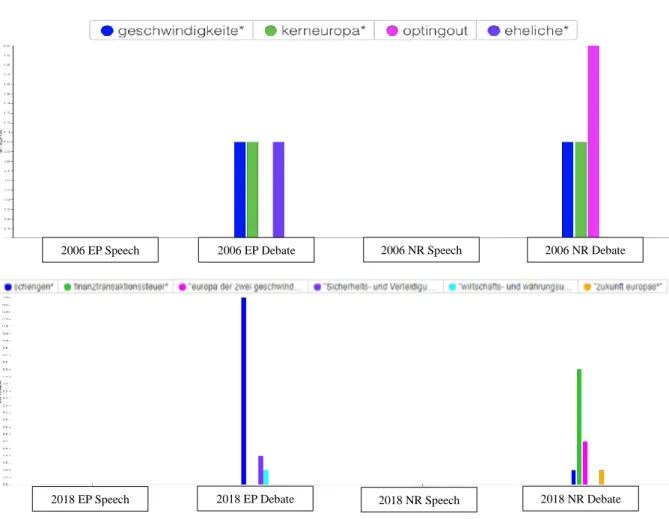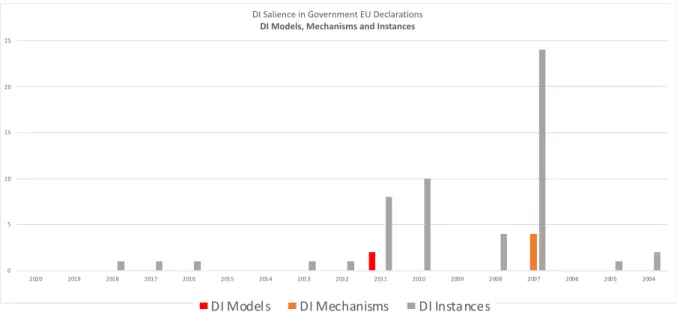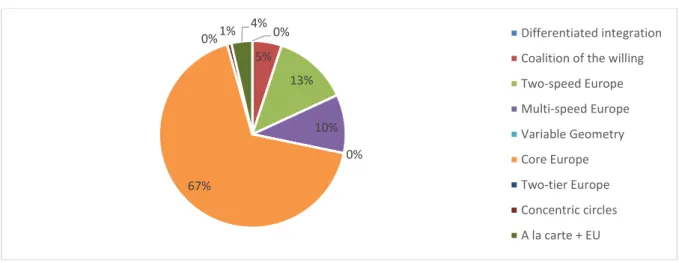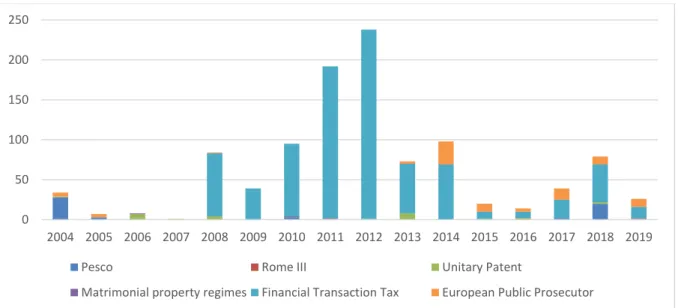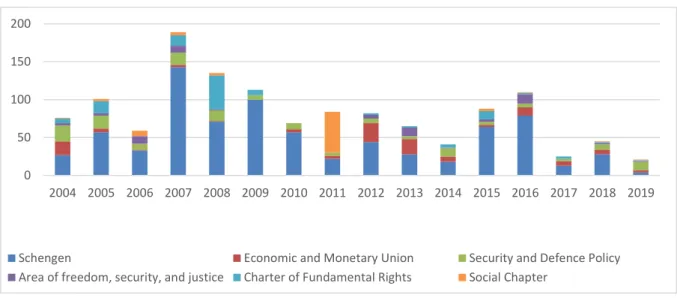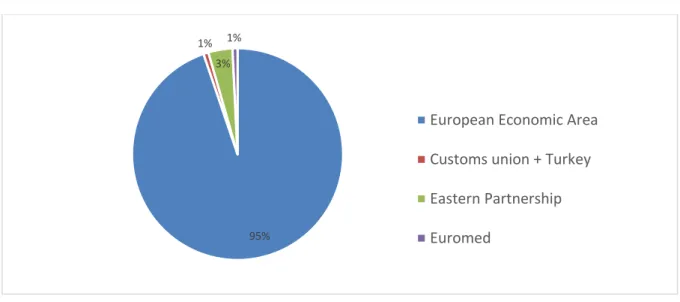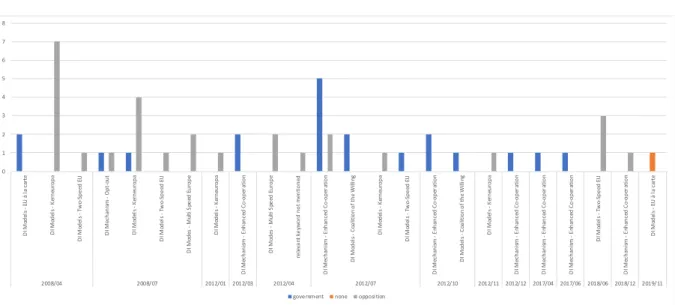RSCAS 2020/80
Robert Schuman Centre for Advanced Studies
Integrating Diversity in the European Union (InDivEU)
The Politics of Differentiated Integration:
What do Governments Want? Country Report – Austria
Katrin Auel and Anna Pixer
European University Institute
Robert Schuman Centre for Advanced Studies
Integrating Diversity in the European Union (InDivEU)
The Politics of Differentiated Integration:
What do Governments Want? Country Report – Austria
Katrin Auel and Anna Pixer
EUI Working Paper RSCAS 2020/80
Terms of access and reuse for this work are governed by the Creative Commons Attribution 4.0 (CC- BY 4.0) International license. If cited or quoted, reference should be made to the full name of the author(s), editor(s), the title, the working paper series and number, the year and the publisher.
ISSN 1028-3625
© Katrin Auel and Anna Pixer, 2020
This work is licensed under a Creative Commons Attribution 4.0 (CC-BY 4.0) International license.
https://creativecommons.org/licenses/by/4.0/
Published in November 2020 by the European University Institute.
Badia Fiesolana, via dei Roccettini 9 I – 50014 San Domenico di Fiesole (FI) Italy
Views expressed in this publication reflect the opinion of individual author(s) and not those of the European University Institute.
This publication is available in Open Access in Cadmus, the EUI Research Repository:
https://cadmus.eui.eu
Robert Schuman Centre for Advanced Studies
The Robert Schuman Centre for Advanced Studies, created in 1992 and currently directed by Professor Brigid Laffan, aims to develop inter-disciplinary and comparative research on the major issues facing the process of European integration, European societies and Europe’s place in 21st century global politics.
The Centre is home to a large post-doctoral programme and hosts major research programmes, projects and data sets, in addition to a range of working groups and ad hoc initiatives. The research agenda is organised around a set of core themes and is continuously evolving, reflecting the changing agenda of European integration, the expanding membership of the European Union, developments in Europe’s neighbourhood and the wider world.
For more information: http://eui.eu/rscas
The EUI and the RSCAS are not responsible for the opinion expressed by the author(s).
Integrating Diversity in the European Union (InDivEU) is a Horizon 2020 funded research project aimed at contributing concretely to the current debate on the ‘Future of Europe’ by assessing, developing and testing a range of models and scenarios for different levels of integration among EU member states.
InDivEU begins from the assumption that managing heterogeneity and deep diversity is a continuous and growing challenge in the evolution of the EU and the dynamic of European integration. The objective of InDivEU is to maximize the knowledge of Differentiated Integration (DI) on the basis of a theoretically robust conceptual foundations accompanied by an innovative and integrated analytical framework, and to provide Europe’s policy makers with a knowledge hub on DI. InDivEU combines rigorous academic research with the capacity to translate research findings into policy design and advice.
InDivEU comprises a consortium of 14 partner institutions coordinated by the Robert Schuman Centre at the European University Institute. The scientific coordinators are Brigid Laffan (Robert Schuman Centre) and Frank Schimmelfennig (ETH Zürich). For more information, visit http://indiveu.eui.eu/
The research leading to this report was conducted within the InDivEU project. The project has received funding from the European Union’s Horizon 2020 research and innovation programme under grant agreement No. 822304. The funders had no role in the study design, data collection or analysis.
Abstract
This working paper investigates the salience of and the position on Differentiated integration (DI) for the Austrian government. The analysis is based on both an analysis of government programmes, programmatic government speeches and parliamentary debates between 2004 and 2019/20. It shows that DI is overall not a salient issue in Austria, at least with regard to general DI concepts and models.
Specific instances of DI were, of course, subjects of intense debates but, with very few exceptions such as the financial transaction tax as an instance of enhanced cooperation, rarely discussed with specific reference to DI. Overall, most Austrian parties are also not generally in favour of DI, quite the opposite.
The dominant vision of the EU is that of a community of closely cooperating Member States with the same rights and responsibilities where opt-outs are seen as cherry picking. Only one party has forcefully supported the development of a core Europe, namely the right-wing populist Bündnis Zukunft Österreich (Alliance for the Future of Austria, BZÖ). In this case, however, DI is mainly regarded as a means to exclude groups of Member States (especially the financially more vulnerable or net recipients) from areas of integration.
Keywords
Differentiated Integration; Austria; Parliamentary Debates; Enhanced Cooperation; Opt-out.
Summary of Results
I. Salience
Differentiated integration (DI) is overall not a salient issue in Austria, at least with regard to general concepts and models. Since 2004, the topic has only come up very infrequently in government programmes, programmatic speeches by the Chancellor or other members of the cabinet and parliamentary debates. Specific instances of DI, by contrast, are far more salient for the Austrian government. This seems to be more due to the instruments themselves, rather than to their DI character.
Clearly, Schengen, Economic and Monetary Union (EMU), Common Security and Defence Policy (CSDP), the European Stability Mechanism (ESM), the Fiscal Compact and the European Public Prosecutor, to name just a few instances, were subjects of intense debates. They are rarely discussed with specific reference to DI, however. The only exceptions are: the financial transaction tax (FTT), which was discussed in the context of the enhanced cooperation mechanism; regarding the opt-out mechanism, the introduction of a general opt-out option for all Member States from (certain) genetically modified organisms (GMO); and a limited domestic opt-out for hospital staff from the working time directive.
II. Position
Overall, most Austrian parties are not in favour of DI, quite the opposite. While the subsidiarity principle and concentrating on the main tasks of the European Union (EU) have always been important in Austrian discourse, the vision of the EU is that of a community of closely cooperating Member States with the same rights and responsibilities where opt-outs are seen as cherry picking. Regarding the latter, criticism has especially focused on the United Kingdom’s (UK) opt-out regarding the European Charter of Fundamental Rights. Interestingly, over time most parties use the term core Europe more rarely and rather refer to a rather negatively connotated Europe à la carte or Europe of two/multiple speeds. Only one party has openly and forcefully supported the development of a core Europe of the economically most successful Member States or net payers, namely the right-wing populist Bündnis Zukunft Österreich (Alliance for the Future of Austria, BZÖ). In this case, however, the support for DI is based less on an aim to allow a small group of Member States to move ahead in specific areas but more as a means to exclude groups of Member States (especially the financially more vulnerable or net recipients) from areas of integration.
Table of Contents
1. Introduction ... 1
2. The salience of DI ... 1
2.1 Government programmes ... 1
2.2 Key Speeches by the Prime Minister (Chancellor) ... 3
2.3 Parliamentary Debates ... 7
3. The government position on DI ... 11
3.1 Government programmes and speeches ... 11
3.1.1 DI models ... 11
3.1.2 DI mechanisms and instances ... 13
3.2 Parliamentary Debates... 14
3.2.1 DI models ... 15
3.2.2 DI mechanisms ... 17
4. Conclusion ... 18
Appendices ... 19
List of Figures Figure 1 - Salience of EU-related issues in Austrian government programmes 2002-2020 (relative word frequencies, aggregated across all programmes) ... 2
Figure 2 - Salience of EU-related issues in first speeches and subsequent parliamentary debates (relative word frequencies aggregated across all speeches and debates) ... 3
Figure 3 - DI keywords in speeches and parliamentary debates related to the 2006 and 2018 Council presidencies (absolute numbers) ... 5
Figure 4 - Salience of DI models, mechanisms and instances in government EU declarations, 2004-2020 (absolute numbers) ... 6
Figure 5 - Salience of conceptual key words in parliamentary debates 2004-2019 (absolute numbers) ... 8
Figure 6 - Salience of conceptual key words in parliamentary debates 2004-2019 – breakdown by keyword (in percentages) ... 8
Figure 7 - Salience of DI mechanisms in parliamentary debates 2004-2019 (aggregated absolute numbers) 9 Figure 8 - Salience of instances of enhanced cooperation in parliamentary debates 2004-2019 (absolute numbers) ... 9
Figure 9 - Salience of instances related to the opt-out mechanism in parliamentary debates 2004-2019 (absolute numbers) ... 10
Figure 10 - Salience of inter se agreements in parliamentary debates 2004-2019 (abs. numbers) ... 10
Figure 11 - Salience of association agreements in parliamentary debates 2004-2019 (percentages) ... 11
Figure 12 - Mentions of DI models and mechanisms in parliamentary debates 2004-2019 by government status (absolute numbers) ... 15
Figure 13 - References to and assessments of DI models by government and opposition actors ... 15
Figure 14 - References to and assessments of the enhanced cooperation and opt-out DI mechanisms by government and opposition actors ... 18
1
1. Introduction
This report investigates the salience of differentiated integration (DI) in Austrian government discourse between 2004 and 2020. It also probes into the position of Austrian governments on the issue of DI in selected peak-salience years (2008, 2012, 2017-2019/20). Regarding the salience of DI, the results are based on counting DI-related keywords in a variety of document types. Regarding the position of the government, the results are based on a manual sentiment analysis of parliamentary debates. To this end, parliamentary debates were manually coded using Max QDA software.
The material analysed for this report includes government programmes, Chancellors’ speeches, first government declarations, EU declarations, European Council statements and parliamentary debates.
Appendix 1 provides an overview of all the documents analysed. German keywords (see Appendix 2 for an overview) were searched using the stem of the word to include all permutations due to conjugation or declination. In addition, as actors sometimes use English terms, we searched for these as well (e.g.
coalition of the willing, enhanced cooperation, opt-out, variable geometry and PESCO – Permanent Structured Cooperation).
The assumption underlying the keyword counts is that the more a government talks about DI, the more relevant it is. While keyword counts in government programmes and PM speeches show the salience of DI at specific moments in time, analysis of parliamentary debates allowed us to identify trends over time and situational peaks. The list of keywords reflects three levels of abstraction. First, we ask if governments talk about DI at a conceptual level, i.e. by discussing the advantages and pitfalls of different models of DI. Second, we ask to what extent governments talk about specific DI mechanisms, such as enhanced cooperation and opt-outs from community policies. Finally, we ask what the differentiated policy fields which governments talk about most often are. Besides instances of enhanced cooperation and opt-outs from community policies, the report also looks at instances of inter-state agreements and external agreements.
2. The salience of DI
2.1 Government programmes
To assess the salience of DI for the Austrian government, we first analysed the six Austrian government programmes1 between 2003 and 2020. The computer-assisted word count resulted in only two references to DI models, both of which were in the 2008 programme of the first Faymann government. In addition, we found a number of references to instances of DI in all the programmes, namely to security and defence policy, Schengen and Economic and Monetary Union, which are all related to the opt-out DI mechanism, and to PESCO, the financial transaction tax and the European Public Prosecutor, which are related to the enhanced cooperation DI mechanism. In both cases, the programmes mainly referred to the instances and only very rarely to the underlying mechanisms – with one exception in the 2013 programme, which referred to enhanced cooperation in connection with the financial transaction tax (see Appendix 3).
To investigate this further, two additional analyses were conducted. First, a qualitative analysis of the government programmes confirmed that the terms were rarely discussed in a more detailed DI context. For example, the 2013 programme of the second Faymann government mentioned the financial transaction tax three times, twice simply stating that the government intended to pursue its introduction,
1 Between 2002 and 2020, Austria had 7 governments, of which one, in 2019, was a caretaker government under Chancellor Bierlein after a successful no confidence vote against Chancellor Kurz. The Bierlein government did not draw up a government programme.
Katrin Auel and Anna Pixer
2 Robert Schuman Centre for Advanced Studies Working Papers
and once referring to enhanced cooperation: “The introduction of a financial transaction tax will be pursued. Austria will participate in an introduction within the framework of enhanced cooperation; in addition, it will continue its efforts regarding a preferable global introduction.”2
Second, we ran a computer assisted word count analysis to measure the overall salience of the EU and EU-related topics in the government programmes. As Figure 1 shows, Europe and the European Union were of high, albeit slightly decreasing, salience in the 2002 to 2013 government programmes, with the highest relative salience in the 2003 programme of the coalition of the conservative ÖVP with the extreme right Austrian Freedom Party (Freiheitliche Partei Österreich, FPÖ).3 The high salience of EU-related issues only changed with the first Kurz government in 2017, again a coalition of the ÖVP and the Austrian Freedom Party. Yet although in this government programme the greater relative salience of the term ‘Austria’ (österreich*) clearly indicates a more domestic outlook, references to the EU are still more frequent than those to all the other terms included. The programme of the current ÖVP/Greens coalition follows this trend: the salience of terms related to both Austria and the EU increased relative to the other terms, but overall Austrian topics remain more salient.
Figure 1 - Salience of EU-related issues in Austrian government programmes 2002-2020 (relative word frequencies, aggregated across all programmes)
Note: The terms used in the query were all permutations of, in this order, Austria*, EU*, social*, economic, government*, culture*, citizen*
and politic*.
One of the reasons for the relative frequency of EU-related terms is the fact that the government programmes include a section or chapter on EU integration, usually in combination with foreign policy, but also address EU policy issues throughout the whole programme. Therefore, each chapter outlining government plans in a specific policy area usually also mentions policies the government will pursue or support at the EU level.
2 “Die Einführung einer Finanztransaktionssteuer wird weiterhin vorangetrieben. Österreich wird sich an einer Einführung im Rahmen der verstärkten Zusammenarbeit beteiligen, darüber hinaus wird es die Bestrebungen zu einer möglichst weltweiten Einführung weiterführen” (2013 government programme, p. 105).
3 The 2003 to 2007 coalition was the second involving the ÖVP and the FPÖ under Chancellor Schüssel. Especially the strong negative reaction within the EU to the first formation of the coalition in 2000, including sanctions, may have been a reason why the coalition put special emphasis on EU issues in its subsequent programme. It is also by far the shortest of the government programmes.
2003 2007 2008 2013 2017 2020
The Politics of Differentiated Integration: What do Governments Want? Country Report – Austria
European University Institute 3
2.2 Key Speeches by the Prime Minister (Chancellor)
Second, we analysed the first speeches of the Chancellor4 after each election (government declarations) in both chambers of the Austrian Parliament and the ensuing debates. In the former, keywords related to DI played an even smaller role than in the government programmes. Overall, we found only five mentions in speeches in the lower chamber (National Council, Nationalrat, NR) and two references in speeches in the upper chamber (Federal Council, Bundesrat, BR). With the exception of the financial transaction tax (two mentions) the mentions referenced EU security and defence policy. Security and defence policy and Schengen also played somewhat bigger roles in the subsequent parliamentary debates (Appendix 4), while other instances of DI were hardly mentioned. Here, the timing of the first government declarations clearly played a role. In 2013, for example, most decisions regarding the establishment of the European Stability Mechanism had already been made. Chancellor Faymann did not refer to it in 2013, and the term was only mentioned once in the following Nationalrat debate.
Figure 2 provides an overview of the aggregated relative frequencies of EU-related terms in the seven speeches and the following debates. It shows that the Chancellors’ speeches were overall more focused on Austrian politics than the government programmes, although references related to Europe or the EU were still fairly frequent – and more frequent than in the following parliamentary debates.
Figure 2 - Salience of EU-related issues in first speeches and subsequent parliamentary debates (relative word frequencies aggregated across all speeches and debates)
Note: The terms used in the query were all permutations of, in this order, government, Austria*, EU*, social*, economic, politic*, citizen* and cultur*
Third, we turned to an analysis of the Chancellors’ speeches on the occasions of the EU Council presidencies in 2006 and 2018 and found a very similar picture regarding DI. Here, we analysed speeches in the European Parliament (EP), speeches outlining the government’s priorities for the Council presidency and the subsequent parliamentary debates in the Austrian and European
4 The speeches for the 2017 and 2020 government were given by Chancellor Kurz and Vice Chancellors Strache and Kogler.
We coded the latter too. The government declarations by Chancellor Kurz in both years were overall rather short and gave only a broad overview of the government’s vision for the next four years. The speeches by his vice chancellors went into some more detail, and especially Vice Chancellor Kogler (Greens) spent more time on EU issues in 2020, but DI hardly played a role. Chancellor Bierlein, in turn, defined the role of her unelected caretaker government as “verwalten, nicht gestalten” (caretaking, not decision-making) and did not give a programmatic speech.
NR First Speeches NR Debates BR First Speeches BR Debates
Katrin Auel and Anna Pixer
4 Robert Schuman Centre for Advanced Studies Working Papers
Parliaments.5 Overall, DI hardly played a role in the speeches. In his statement in the Nationalrat in January 2006, Chancellor Schüssel mainly focused on the results of the European Council meeting on 15 and 16 December 2005 regarding the 2007-2012 Multiannual Financial Framework. In addition, he gave a short overview of the government’s presidency priorities, focussing mainly on growth and employment, EU research policy, internal security, enlargement and the continuing debate on the EU draft constitution. Schüssel’s speech in the EP in January 2006 expanded this list of issues slightly, also highlighting EU energy security, touching on the Services Directive and mentioning the need for a financial transaction tax (without using the term as such). In 2018, the three main priorities outlined by Chancellor Kurz both in the national and the European Parliaments were external border control, Frontex and illegal migration, the development of the EU digital market and infrastructure, and the enlargement prospects for the western Balkans. None of the four speeches contained one of the specific key terms related to DI.
It is perhaps not surprising that overall speeches on the occasion of taking over the Council presidency focus more on a united Europe rather than on different options for DI that may be interpreted as dividing the Union. DI issues were, however, overall also not salient in the ensuing debates, either in the Nationalrat or the European Parliament.
In 2006 (see Figure 3), in both the Nationalrat debate and the debate in the European Parliament, Chancellor Schüssel was asked about French proposals for a “core Europe.” In the EP debate, another MEP also raised the question of a “two-tier Europe”’ (Europe of two speeds in German) with regard to the transitional arrangements regarding the free movement of workers, but Chancellor Schüssel did not take up either issue in his replies. The term ‘opt-out’ (here ‘opting out’), in turn, was mentioned twice in the Nationalrat, but in the context of a complaint by a Member of Parliament (MP) about an increase in “euro speak" and not with any connection to the mechanism as such. Finally, a reference to matrimonial property regimes was made by European Commission president José Manuel Barroso.
5 Neither Schüssel nor Kurz presented the Council presidency priorities in a plenary session of the upper chamber, the Bundesrat.
The Politics of Differentiated Integration: What do Governments Want? Country Report – Austria
European University Institute 5
Figure 3 - DI keywords in speeches and parliamentary debates related to the 2006 and 2018 Council presidencies (absolute numbers)
In 2018, the only more salient DI issue in the Nationalrat was the financial transaction tax, which was raised by several Austrian MPs in the debate. In addition, one MP referred to a “two-speed Europe” but not in the context of formal DI but instead as a spectre due to differences between Member States regarding investments in digitalisation and digital access: “When it comes to digitalisation, we do not want a Europe of two speeds”(MP Stephanie Cox, Liste Pilz, 14 June 2018).6 In the European Parliament debate following Kurz’s speech in 2018, Schengen was the only more frequently found key term. While Kurz did not mention Schengen as such, either in his speech or his later reply, the issue was raised by several Members of the European Parliament (MEPs), mainly in relation to migration policy and the EU’s internal borders but not related to the opt-out DI mechanism.
Unfortunately, we were not able to include Future of Europe (FoE) debates as no Austrian representative gave a FoE speech in the European Parliament. European citizens’ dialogues took place in Austria between June and November 2018 in the context of the Austrian Council presidency, but Chancellor Kurz did not give a specific speech on this occasion in the Austrian Parliament. The kick- off for the citizens’ dialogues was celebrated in the context of the Europa-Forum Wachau in June 2018,
6 “Jene EU Länder, die bei der Digitalisierung EU-weit am weitesten vorne sind, sind es auch weltweit, und im globalen Kontext spiegelt sich auch wider, welche Länder in der EU weiter hinten sind. Das bedeutet … alle Mitgliedstaaten sollten mehr investieren, um den digitalen Binnenmarkt voll ausschöpfen zu können. Wir wollen bei der Digitalisierung kein Europa der zwei Geschwindigkeiten haben.” (Nationalrat debate, 14 June 2018).
2006 EP Speech 2006 EP Debate 2006 NR Speech 2006 NR Debate
2018 EP Speech 2018 EP Debate 2018 NR Speech 2018 NR Debate
Katrin Auel and Anna Pixer
6 Robert Schuman Centre for Advanced Studies Working Papers
but Kurz’s speech on this occasion is not available.7 According to the news coverage of the speech, however, Kurz mainly focused on the presidency priorities outlined above and did not discuss DI.8
Finally, we also analysed the statements Chancellors made in Parliament related to European Council meetings. According to §74, para. 1 of the standing orders of the Austrian Nationalrat, the Government presents an EU declaration twice a year “in close proximity to the European Council meetings”9 to provide the Nationalrat with information on issues and the impacts on Austria and on the position of the government. These declarations can be made by any member of the government, but it is usually the Chancellor together with the Vice Chancellor or one other minister10 and very rarely a minister on his or her own. The declarations are then also transmitted to the Bundesrat in writing.
As the word count for the 24 declarations indicates, DI overall was only occasionally salient (Figure 4). DI models were only explicitly mentioned twice, both in the same declaration in 2011 referring to a multi-speed Europe. Similarly, the opt-out DI mechanism was the only one mentioned, twice each in two speeches in 2007 related to the British opt-out from the Charter of Fundamental Rights. As the count of DI instances shows, however, issues related to DI were somewhat more salient than the model and mechanism word counts suggest.
Figure 4 - Salience of DI models, mechanisms and instances in government EU declarations, 2004-2020 (absolute numbers)
A breakdown of the references to DI instances show a clear focus on the financial transaction tax, Schengen, the Charter of Fundamental Rights and the European Stability Mechanism (Appendix 5).
Association agreements were not mentioned at all. Note, however, that the relatively low number of mentions regarding the European Stability Mechanism and the Fiscal Compact is not really
7 The website of the Europa-Forum does not make the speech available, and a YouTube video of the whole speech was made private. See https://kurz-link.at/2JUsYQZ.
8 E.g. https://www.nzz.ch/international/der-westbalkan-braucht-reale-eu-perspektiven-ld.1395912,
https://www.kleinezeitung.at/politik/politikaufmacher/5448128/EuropaForum-Wachau_Kurz-plaediert-fuer-schlankere- fokussierte-EU
9 “EU-Erklärungen von Mitgliedern der Bundesregierung finden zweimal pro Jahr in zeitlicher Nähe zu einer Tagung des Europäischen Rates oder Rates der EU statt. Sie dienen der Information des Nationalrates über Themen des Europäischen Rates oder Rates der EU, deren Auswirkungen auf Österreich und die Positionen der Österreichischen Bundesregierung dazu.”
10 In these cases, the speeches were analysed together as one document.
0 5 10 15 20 25
2020 2019 2018 2017 2016 2015 2014 2013 2012 2011 2010 2009 2008 2007 2006 2005 2004
DI Salience in Government EU Declarations DI Models, Mechanisms and Instances
DI Model s DI Mechanisms DI Instances
0 5 10 15 20 25
2020 2019 2018 2017 2016 2015 2014 2013 2012 2011 2010 2009 2008 2007 2006 2005 2004
DI Salience in Government EU Declarations DI Models, Mechanisms and Instances
DI Model s DI Mechanisms DI Instances
The Politics of Differentiated Integration: What do Governments Want? Country Report – Austria
European University Institute 7
representative of the content of the declarations in 2011 to 2013, which often focused on the crisis and the related measures. Government representatives rather tended to use other terms related to the mechanism, such as ‘Schutzschirm’ or ‘Rettungsschirm’ (protective shield/parachute, a German term often used for ‘bailout fund’) (Figure 9). In addition, the specific oratory styles of the Chancellors and their colleagues play a role. While some use a term once, others repeat it several times for emphasis.
Chancellor Gusenbauer, for example, mentioned the European Charter of Fundamental Rights in four consecutive sentences in his November 2008 EU declaration.
These DI references were embedded in broader issue cycles in the EU declarations (Appendix 6).
While the declarations in 2007 were dominated by the negotiations on the constitutional/Lisbon Treaty, the financial and eurozone crises became the topic from 2009 onwards, being replaced by the refugee crisis in 2015 and 2016 – even if the term crisis is overall not very often mentioned. Finally, from July 2016 on, Brexit became the top issue even though government representatives only started using the term in 2017.
2.3 Parliamentary Debates
We then broadened the analysis and turned to parliamentary debates in both chambers of the Austrian Parliament between 2004 and 2019. Here, we had to focus on plenary debates, as the committees in the two houses meet behind closed doors and do not provide stenographic minutes.
To start with an overview, Figure 5 provides the results of a manual search for keywords related to DI models using the Parliament’s search engine. It shows an overall very low salience of DI models in Austrian parliamentary debates, with an average of just over eight mentions a year (N=138). DI models were relatively more salient in the years between 2007 and 2010 with another, much lower, peak in 2016. It is entirely possible that DI models played a greater role in committee debates. At the same time, we would argue that references in plenary debates, less frequent as they may be, do provide interesting insights given the public and media impact of plenary debates.
As a comparison, we added the key term ‘future of Europe’ (“Zukunft der EU/Europas”) to the manual count (Appendix 7). The salience of the two sets of terms seem to follow somewhat different logics, with ‘future of Europe’ being salient in almost the opposite time periods to DI models. The only exception is the year 2007, for which we recoded a relatively high salience for both. Indeed, the correlation between the frequencies of the two terms is positive but extremely small with a Pearson’s r of .009.
Katrin Auel and Anna Pixer
8 Robert Schuman Centre for Advanced Studies Working Papers
Figure 5 - Salience of conceptual key words in parliamentary debates 2004-2019 (absolute numbers)
A breakdown of the absolute numbers according to the different conceptual keywords related to DI also shows that the overwhelming majority of the references are to the DI model of an EU of multiple endpoints, and mainly to the term ‘core Europe’ (Kerneuropa), namely 67 per cent (Figure 6). These are followed by terms referring to a Europe of two or different speeds. The other keywords played no or only a very small role. We investigated this further by analysing the three peak years, 2007, 2008 and 2010, where the overall picture looks very similar. Finally, we also included a breakdown for the most recent ‘peak’ in 2016, where the concept of ‘coalition of the willing’ became as salient as core Europe.
Note, however, that the absolute number of references in 2016 is only eight (see Appendix 8).
Figure 6 - Salience of conceptual key words in parliamentary debates 2004-2019 – breakdown by keyword (in percentages)
DI mechanisms were slightly less salient in the parliamentary debates, with a total of 124 mentions of the terms ‘enhanced cooperation’ or ‘opt-out’ (Figure 7). A breakdown between the two mechanisms shows that the absolute frequency of the mentions followed different cycles. The opt-out mechanism was referred to in the period from 2005 to 2011 and then again from 2014 to 2016, with peaks in 2007,
0 5 10 15 20 25 30 35
2004 2005 2006 2007 2008 2009 2010 2011 2012 2013 2014 2015 2016 2017 2018 2019 Differentiated integration Coalition of the willing Two-speed Europe
Multi-speed Europe Variable Geometry Core Europe Two-tier Europe Concentric circles A la carte + EU
0%
5%
13%
10%
0%
67%
0%1% 4%
Differentiated integration Coalition of the willing Two-speed Europe Multi-speed Europe Variable Geometry Core Europe Two-tier Europe Concentric circles A la carte + EU
The Politics of Differentiated Integration: What do Governments Want? Country Report – Austria
European University Institute 9
2011, 2014 and 2015. In 2011 and 2014, the debates focused almost entirely on the working time directive and the question of a general opt-out and a specific Austrian opt-out from the maximum working hours for medical hospital personnel. In 2007, by contrast, the debates focused on the EU Charter of Fundamental Rights and the British opt-out in particular, and in 2015 on the opt-out option regarding the cultivation of genetically modified organisms (GMOs).11 The enhanced cooperation DI mechanism, in turn, was mainly debated in 2012 and in connection with the introduction of a financial transaction tax, with only a few further mentions from 2015 to 2018.
Figure 7 - Salience of DI mechanisms in parliamentary debates 2004-2019 (aggregated absolute numbers)
Specific instances of DI, however, were far more salient in the parliamentary debates, even though the related mechanisms were generally not mentioned specifically. As Figure 8 indicates, the Austrian Parliament debated instances of enhanced cooperation throughout the period under investigation (n=1047), and especially intensely between 2008 and 2014, with another, smaller, peak in 2018. At the same time, its salience is driven almost exclusively by debates on the financial transaction tax, of which Austria is a strong supporter.
Figure 8 - Salience of instances of enhanced cooperation in parliamentary debates 2004-2019 (absolute numbers)
11 Directive (EU) 2015/412 of the European Parliament and of the Council of 11 March 2015 amending Directive 2001/18/EC as regards the possibility for the Member States to restrict or prohibit the cultivation of genetically modified organisms (GMOs) in their territory. Text with EEA relevance.
0 10 20 30 40
2004 2005 2006 2007 2008 2009 2010 2011 2012 2013 2014 2015 2016 2017 2018 2019 Enhanced cooperation opt-out
0 50 100 150 200 250
2004 2005 2006 2007 2008 2009 2010 2011 2012 2013 2014 2015 2016 2017 2018 2019
Pesco Rome III Unitary Patent
Matrimonial property regimes Financial Transaction Tax European Public Prosecutor
Katrin Auel and Anna Pixer
10 Robert Schuman Centre for Advanced Studies Working Papers
This is even more the case for instances related to the opt-out DI mechanism, which were discussed somewhat more evenly throughout the period (n=1303). Here, we also find an, albeit only slightly, more even distribution. While Schengen was the most intensely discussed instance, all other instances also played a role.
Figure 9 - Salience of instances related to the opt-out mechanism in parliamentary debates 2004- 2019 (absolute numbers)
While above we have focused on mechanisms and instances of internal DI, i.e. on forms of DI regulated in the EU Treaties, instances of external DI exist as well. Here, the most prominent mechanisms are the inter se agreements (ISA), which are international agreements between all or a subgroup of the EU Member States concluded outside of the Treaties, on the one hand, and association agreements between the EU and (groups of) other countries, on the other.
Overall, inter se agreements (word count n=2125) were far more salient in Austria than association agreements (word count n=650) over the period under observation (Figure 10). The distribution of ISA mentions over time and in a breakdown according to the specific inter se agreements mentioned indicates that the high salience is almost exclusively due to the ISA concluded in the context of the eurozone crisis, namely the European Stability Mechanism and the Fiscal Compact. Both, and especially the ESM, were subject to extensive debates in Parliament.
Figure 10 - Salience of inter se agreements in parliamentary debates 2004-2019 (abs. numbers)
0 50 100 150 200
2004 2005 2006 2007 2008 2009 2010 2011 2012 2013 2014 2015 2016 2017 2018 2019
Schengen Economic and Monetary Union Security and Defence Policy Area of freedom, security, and justice Charter of Fundamental Rights Social Chapter
0 200 400 600 800 1000 1200 1400
2004 2005 2006 2007 2008 2009 2010 2011 2012 2013 2014 2015 2016 2017 2018 2019 Prum Convention European Stability Mechnism: Fiscal Compact
Single Resolution Mechanism Unified Patent Court
The Politics of Differentiated Integration: What do Governments Want? Country Report – Austria
European University Institute 11
Regarding the four association agreements included in the analysis, the breakdown in Figure 11 shows that the European Economic Area (EEA) was by far the most frequently mentioned. The relationship between the EU and Turkey, by contrast, is a highly salient topic in Austria, but was mainly discussed in relation to a potential accession to the EU, which is opposed by most parties in Parliament. The customs union with Turkey, in turn, was very rarely mentioned. More surprising is the rarity of mentions of the Eastern Partnership given Austria’s geographical position. One reason might be that debates in Austria have, especially more recently, mainly focused on the western Balkans rather than the countries included in the Partnership.
Figure 11 - Salience of association agreements in parliamentary debates 2004-2019 (percentages)
3. The government position on DI
In this section, we analyse the position of consecutive Austrian governments and in parliament towards DI. The analysis is based first on a careful reading and qualitative assessment of the government programmes and chancellor speeches mentioned in part 1 and second on a qualitative coding of parliamentary debates in both houses of the parliament in 2008, 2012 and from 2017 to 2019.
3.1 Government programmes and speeches
3.1.1 DI models
As the analysis in part 1 indicated, DI was clearly not a salient issue in the context of government programmes, government speeches or the following parliamentary debates. Despite the low salience, however, it seems clear that the Austrian government is not in favour of general forms of DI, for example a core Europe or a Europe of different speeds. This opposition to DI was only spelled out in the 2008 government programme. Here, the incoming new grand coalition between the social democrats (SPÖ) and the Austrian Peoples‘ Party (ÖVP) explicitly rejected the introduction of general forms of DI:
“Austria will also in the future participate actively, fully and equally in all EU policy areas. We reject variable geometries that exclude Austria. Generally, we oppose new dividing lines in Europe (e.g. in the form of a core Europe).”12 Until 2013, all government programmes also emphasised the full and active
12 “Österreich wird auch in Zukunft an allen EU-Politikbereichen aktiv gestaltend, voll und gleichberechtigt teilnehmen.
Variable Geometrien unter Ausschluss Österreichs lehnen wir ab. Generell sprechen wir uns klar gegen neue Trennlinien 95%
1%
3%
1%
European Economic Area Customs union + Turkey Eastern Partnership Euromed
Katrin Auel and Anna Pixer
12 Robert Schuman Centre for Advanced Studies Working Papers
participation of Austria in all EU policy areas – including the Common Defence Policy, despite Austria’s constitutionally guaranteed neutrality. At the same time, subsidiarity and core EU tasks have always been in the focus of the government but have become more strongly emphasised recently, especially under Chancellor Kurz since 2017.
Consecutive Austrian governments have also always been strong supporters of the accession prospects of the western Balkans, while the Eastern Partnership is important but emphasised less.
Regarding the latter, the tone has also become somewhat stricter over time, with the government programme in 2013 demanding clear signs of a willingness to reform and emphasising the distinction between neighbourhood policy and enlargement.13 The most recent programme, finally, only mentions the EU’s neighbourhood in connection with a demand for EU action to stabilise the situation in the Mediterranean neighbourhood,14 on the one hand, and with regard to this region’s contribution to the EU’s external border security, on the other: “The countries on the EU's external border have earned appropriate support from the EU and its Member States in protecting and controlling the external border.”15
The same is true for Turkey. While the customs union with Turkey was not an issue during the period under investigation, the official discourse in the government programmes, never fully in favour of accession, changed from adhering to the decisions made at the 2002 Copenhagen European Council meetings (2003) to advocating slow, careful and open-ended accession negotiations16 and preferring a
“tailored partnership”17 (2007, 2008, 2013) to explicitly opposing accession and searching for allies in favour of a “neighbourhood concept” (2017).18
The issues discussed above suggest that at least with regard to EU external relations the Austrian government’s vision is somewhat akin to a Europe of concentric circles, with the western Balkans becoming members of the EU, while other countries in the eastern neighbourhood and Turkey remain, at least for the foreseeable future, in an outer circle.
A somewhat similar position has also been advocated by the Kurz ÖVP/Greens government since 2020 with regard to the eurozone. The programme makes it clear that “no country may enter the eurozone unless it fully and sustainably fulfils the criteria.” In addition, there are clear demands both that all members stick to the rules and that those who do not, regarding the budget rules or the rule of
in Europa (etwa in Form eines Kerneuropa) aus.” Regierungsprogramm 2008-2013, p. 238. All translations from German are by the authors.
13 “Die Bundesregierung wird sich weiterhin sowohl mit Hilfe der Europäischen Nachbarschaftspolitik als auch bilateral dafür einsetzen, dass die östlichen Nachbarstaaten der EU, wie die Ukraine, Moldau, Weißrussland und der Südkaukasus, insbesondere in den Bereichen Demokratisierung, Rechtsstaatlichkeit und Menschenrechte, Fortschritte erzielen. Weitere Schritte können nur erfolgen, wenn der Reformwille ausreichend erkennbar ist, wobei klar zwischen der Nachbarschaftspolitik und der EU-Erweiterung zu unterscheiden ist.” (2013 Government programme, p. 79).
14 “Verstärkter Einsatz Europas zur Stabilisierung der Mittelmeer-Anrainerstaaten in der EU-Nachbarschaft” (2020 Government programme, p. 179).
15 “Die Länder an der EU-Außengrenze haben sich entsprechende Unterstützung der EU und ihrer Mitgliedstaaten beim Schutz und der Kontrolle der Außengrenze verdient” (2020 Government Programme, p. 178).
16 “Ein gezieltes und zugleich behutsames Heranführen der Türkei und ihrer Bevölkerung an europäische Werte und Standards ist im Interesse aller Mitgliedstaaten der Europäischen Union. Österreich hat durchgesetzt, dass die Verhandlungen mit der Türkei einen offenen Ausgang haben. Wir setzen uns für ein schrittweises Vorgehen zunächst mit dem Ziel einer maßgeschneiderten türkisch-europäischen Gemeinschaft ein” (Regierungsprogramm 2007, p. 7f.). The formulation in the 2008 programme is exactly the same. See 2008 Government programme, p. 242f.
17 “Österreich setzt sich für eine maßgeschneiderte Partnerschaft zwischen der EU und der Türkei ein. Einem darüber hinausgehenden Verhandlungsergebnis kann nur mit Einbindung der österreichischen Bevölkerung zugestimmt werden”
(2013 Government programme, p. 78).
18 “Klare Politik gegenüber der Türkei: Keine Zustimmung zu einem EU-Beitritt der Türkei. Verbündete zur Erreichung des endgültigen Abbruchs der EU-Beitrittsverhandlungen zu Gunsten eines Europäisch-Türkischen Nachbarschaftskonzeptes werden gesucht” (2017 Government programme, p. 23).
The Politics of Differentiated Integration: What do Governments Want? Country Report – Austria
European University Institute 13
law, are to be sanctioned.19 A similar demand is made regarding “effective sanctions for Member States which violate the Dublin Agreement by tolerating illegal migration to central Europe and do not act against human traffickers.”20
At the same time, according to the 2020 programme, “Austria positions itself in the EU in favour of a new [working] together rather than the old [working] against each other.”21 This also featured in the speeches by Chancellor Kurz on the occasion of the 2018 Austrian Council presidency. Kurz made a reference to “first and second class members” in the speeches, but in relation to a general increase in conflict and dividing lines among groups of Member States and not specifically in relation to DI: “I have the feeling that it has become much more common among the Member States that one group complains about the other, the north about the south, the west about the east and vice-versa. I, in turn, believe in a united Europe, a Europe of cooperation and a Europe in which first- and second-class Member States do not exist.”22
The two issues mentioned above seem to be, however, two sides of the same coin in that the Austrian government seems to regard the EU as a community of equal and closely cooperating members with the same rights and responsibilities. This also implies a community with clear rules that ought to apply to all members. As a result, the community as a whole, and subgroups such as the eurozone, are, at least in principle, open to all that are willing and able to abide by the rules.
3.1.2 DI mechanisms and instances
Specific mechanisms and instances of DI are occasionally supported, yet only as a second-best alternative if the underlying goal cannot be reached with all Member States. This is, for example, the case of the financial transaction tax, where Austrian governments over the whole period under observation were strong supporters of an EU-wide, and ideally even global, introduction, but finally willing to settle for an introduction through enhanced cooperation. In a 2010 EU declaration, for example, Vice Chancellor and Finance Minister Pröll, ÖVP, reported on the efforts of the Austrian government regarding an EU-wide introduction: “On the financial transaction tax and tax measures at the EU level: Yes, I am for the financial transaction tax. At the meeting of the Euroministers we also made sure that there is a common agreement on the development of this tax and that we push this financial transaction tax massively at the EU level.”23 In July 2012, the fact that at least a sufficient number of Member States were ready to move ahead was celebrated as a success by SPÖ Chancellor Faymann in his report on a European Council Meeting: “Let me also report on the success that the
19 “Europa ist eine Verantwortungs- und Solidargemeinschaft. Wer sich nicht an die gemeinsamen Regeln hält, muss mit Sanktionen rechnen. Es braucht eine klare Haltung der EU-Kommission gegenüber Budgetsündern. Es darf ausnahmslos kein Land der Euro-Zone beitreten, das die Kriterien nicht vollständig und nachhaltig erfüllt. Stärkung des bestehenden Rechtsstaatlichkeitsrahmens und wirksamere Sanktionen bei Verstößen. Denn Rechtsstaatlichkeit ist eine Grundvoraussetzung für die EU-Mitgliedschaft” (2020 Government programme, p. 175).
20 “es braucht wirksame Sanktionen für Mitgliedstaaten, die das Dublin-Abkommen brechen, indem sie illegale Migration nach Mitteleuropa zulassen und nicht gegen Schlepperei vorgehen” (2020 Government programme, p. 178).
21 “Österreich positioniert sich in der EU für ein neues Miteinander statt Rückkehr zu altem Gegeneinander” (2020 Government programme, p. 175).
22 “Und ich habe das Gefühl, dass es unter den Mitgliedstaaten viel zu stark eingerissen ist, dass die einen über die anderen klagen, der Norden über den Süden, der Westen über den Osten und umgekehrt. Ich glaube vielmehr an ein gemeinsames Europa, an ein Europa der Zusammenarbeit und an ein Europa, in dem es nicht Mitgliedstaaten erster und zweiter Klasse gibt” (Kurz Speech in EP, 3 July 2018).
23 “Zur Finanztransaktionssteuer und den steuerlichen Maßnahmen auf europäischer Ebene: Ja, ich bin für die Finanztransaktionssteuer. Wir haben beim Treffen der Eurominister auch dafür gesorgt, dass es eine einhellige Zustimmung zur Erarbeitung und Entwicklung dieser Steuer gibt und dass wir diese Finanztransaktionssteuer auf europäischer Ebene massiv vorantreiben. Es muss gelingen, dass dieses Instrument nicht nur in der Frage der Finanzierung, sondern auch im Sinne des Prinzips von mehr Transparenz in der Europäischen Union Realität wird”
(Nationalrat plenary debate, 19 May 2010, p. 29).
Katrin Auel and Anna Pixer
14 Robert Schuman Centre for Advanced Studies Working Papers
financial transaction tax has also received to date, namely December 2012. The formulation in the declaration is as follows. ‘Therefore, several Member States will submit applications for the establishment of enhanced cooperation in this area so that the tax can be approved in December 2012.’
End of quote. This is more than general assurance, this is a correct necessary step in the interest of our common decision.”24
In addition, Austrian governments have generally been critical of opt-outs, for example regarding the British opt-out from the European Charter of Fundamental Rights. As Chancellor Gusenbauer, SPÖ, stated in November 2007, “one should not omit the fact that there is, of course, a fly in the ointment […]
that Great Britain has opted out – we will see whether Poland will do so as well […] one has to ask the question of how the future development of Europe will look if individual states continue to opt out of common European policies. That will lead to a certain confusion in Europe and does not accomplish the real aim of the European project. I have a lot of empathy for national sensitivities in this context but our goal … is a Europe with the same rights and obligations for all.”25 Here, remarks in the context of an EU declaration, also by Chancellor Gusenbauer in July 2007, sound almost like a premonition: “Then there are a number of states, and Great Britain first of all, which had an opt-out on many questions already in the past and now has one regarding the Charter of Fundamental Rights as well. With regard to Great Britain, one will, of course, have to pose the question of how the relationship with the European Union and Europe ought to look if there are ever more questions where Great Britain does not participate in the integration of Europe. But that is a discussion that has to be held mainly there and that will, in the end, also be decided in Great Britain.”26 At the same time, as was shown earlier, Austrian governments have also, again on occasion, not just supported but actively pursued the inclusion of specific opt-out options in EU legislation, for example regarding GMOs.
3.2 Parliamentary Debates
The final part of this analysis focuses on parliamentary debates in depth. We selected for the analysis all plenary debates in the years 2008, 2012 and from 2017 to 2019 in which either a DI model or the enhanced cooperation or opt-out DI mechanisms were mentioned. This resulted in 14 plenary sessions and 49 coded segments, which is again a strong indicator of the overall low salience of DI in Austria.
The programmes were coded manually using MAXQDA. Figure 12 provides an overview.
24 “Lassen Sie mich noch über den Erfolg berichten, dass auch die Finanztransaktionssteuer hinsichtlich der Vorgehensweise ein Datum bekommen hat, konkret den Dezember 2012. Die Formulierung in den Schlusserklärungen lautet: Deshalb werden mehrere Mitgliedstaaten einen Antrag auf Begründung einer Verstärkten Zusammenarbeit in diesem Bereich stellen, damit die Steuer im Dezember 2012 angenommen werden kann. – Zitatende. Das ist mehr als allgemeine Beteuerung, das ist ein richtiger, notwendiger Schritt im Interesse unseres gemeinsamen Beschlusses” (Nationalrat plenary debate 4 July 2012, p. 54).
25 “Meine sehr verehrten Damen und Herren, man soll dabei nicht verschweigen, dass es natürlich Wermutstropfen gibt, wie zum Beispiel den Wermutstropfen, dass Großbritannien sich ein Opt-out genommen hat – ob es Polen letztendlich auch noch sein wird oder nicht, wird sich noch herausstellen […] weil man sich auch die Frage stellen muss, wie die weitere Entwicklung Europas aussieht, wenn einzelne Staaten sich von der gemeinsamen europäischen Politik immer wieder ein Opt-out nehmen. Das führt nämlich zu einer gewissen Unübersichtlichkeit in Europa und erreicht nicht das, was eigentlich das Ziel des europäischen Projekts ist. Ich habe viel Verständnis für nationale Befindlichkeiten in diesem Zusammenhang, aber unser Ziel wird weiterhin bleiben […], dass wir ein Europa haben, wo es gleiches Recht für alle gibt” (Nationalrat plenary debate, 8 November 2007, p. 38).
26 “Dann gibt es noch eine Reihe von Staaten, in erster Linie Großbritannien, das ein Optout bei vielen Fragen bereits in der Vergangenheit hatte und nun dieses auch in der Frage der Grundrechtecharta hat. Daher wird man sich natürlich vor allem in Bezug auf Großbritannien die Frage stellen müssen, wie das Verhältnis zur Europäischen Union und zu Europa aussehen soll, wenn es immer mehr Fragen gibt, wo Großbritannien nicht an der Einigung Europas beteiligt ist. Aber das ist eine Diskussion, die vor allem dort geführt werden muss und die letztendlich auch in Großbritannien entschieden wird”
(Nationalrat plenary debate, 6 July 2007, p. 99).
